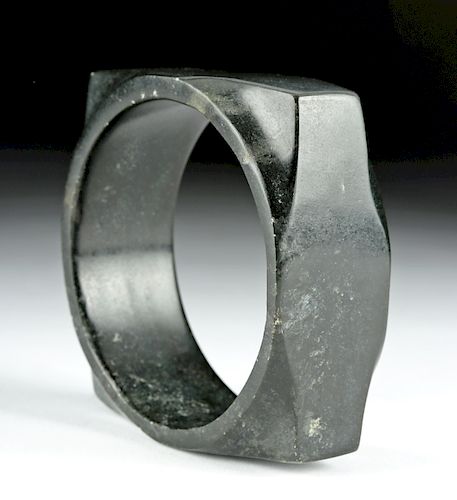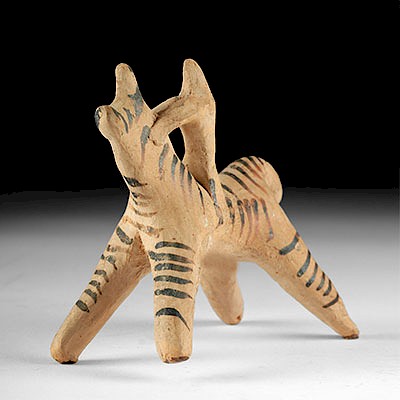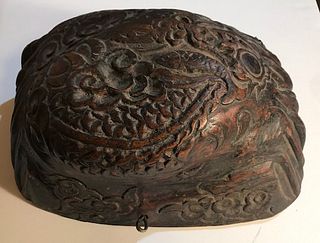Fine Chinese Shang Dynasty Nephrite Cong
Lot 151b
About Seller
Artemis Gallery
686 S Taylor Ave, Ste 106
Louisville, CO 80027
United States
Selling antiquities, ancient and ethnographic art online since 1993, Artemis Gallery specializes in Classical Antiquities (Egyptian, Greek, Roman, Near Eastern), Asian, Pre-Columbian, African / Tribal / Oceanographic art. Our extensive inventory includes pottery, stone, metal, wood, glass and textil...Read more
Categories
Estimate:
$3,000 - $5,000
Absentee vs Live bid
Two ways to bid:
- Leave a max absentee bid and the platform will bid on your behalf up to your maximum bid during the live auction.
- Bid live during the auction and your bids will be submitted real-time to the auctioneer.
Bid Increments
| Price | Bid Increment |
|---|---|
| $0 | $25 |
| $300 | $50 |
| $1,000 | $100 |
| $2,000 | $250 |
| $5,000 | $500 |
| $10,000 | $1,000 |
| $20,000 | $2,500 |
| $50,000 | $5,000 |
| $100,000 | $10,000 |
| $200,000 | $20,000 |
About Auction
By Artemis Gallery
Oct 25, 2018
Set Reminder
2018-10-25 11:00:00
2018-10-25 11:00:00
America/New_York
Bidsquare
Bidsquare : Antiquities from Egypt, Greece, Italy, Asia
https://www.bidsquare.com/auctions/artemis-gallery/antiquities-from-egypt-greece-italy-asia-3538
Featuring Egyptian, Greek, Roman, Etruscan, Near Eastern, plus Asian art from Central and Far East. If you love the classics, this is the sale for you. Artemis Gallery info@artemisgallery.com
Featuring Egyptian, Greek, Roman, Etruscan, Near Eastern, plus Asian art from Central and Far East. If you love the classics, this is the sale for you. Artemis Gallery info@artemisgallery.com
- Lot Description
East Asia, China, Shang Dynasty, ca. 1558 to 1046 BCE. A gorgeous and finely-formed ritual funerary item known as a "cong," carved by hand from mottled dark-green nephrite with black inclusions. The cong bears a square form, four projecting corners with smooth faceted contours, and a central ring drilled through the center with a squat collar around each side. This cong was formed through a meticulous carving and smoothing process using awls, drills, and abrasives of varying fineness, and boasts an incredibly smooth surface which is pleasing to the touch. Size: 3.7" W x 1.375" H (9.4 cm x 3.5 cm).
Chinese art has incorporated jade since the Neolithic period; quarries for nephrite, the type of jade found in China, have been found in modern-day southern Mongolia that date to ca. 4000 BCE. The stone was prized for its hardness, its beautiful coloration, and its durability. Jade was the most valuable item known to the Neolithic Chinese and was associated with the most important rituals of life. Yu, the Chinese word for jade, is also an idea - of a steadfastness, and reliability, mirrored in the abrasion techniques required to make these intricate works of art. Yu is also not bound by the mineralogical definition of jade - over the millennia that it has been carved in China, the people have had varying access to sources of jade and nephrite - but is rather a wider term for hard stone. By the third millennium BCE, we know that jade had also come to be associated with immortality.
During the Shang dynasty, members of the royalty were accompanied in the afterlife by their bronzes, ceramics, weapons, amulets, and ornaments, and even the human and animal entourage that surrounded them in life. Jade items like this one formed part of the decoration of these tombs and seem to have been reserved for the most elite people in society. The funerary function of nephrite jade congs like this example probably had a religious connotation. Some scholars of Chinese Neolithic history and anthropology posit that the cong is "…based on the ancient Chinese notion that earth was square and heaven round, while the hole in the object represents the passage connecting heaven and earth." (Weichao, Yu. "A Journey into China's Antiquity - Volume 1: Palaeolithic Age - Spring and Autumn Period." National Museum of Chinese History, Beijing, China, 1997, p. 80)
For a stylistically-similar example of a longer form, please see The Metropolitan Museum of Art, accession number 02.18.316: https://www.metmuseum.org/art/collection/search/49369
A stylistically-similar example of a larger size but similar stone coloration hammered for HKD 211,500 ($27,028.24) at Christie's, Hong Kong "Important Chinese Jades from the Personal Collection of Alan and Simone Hartman Part II" Auction (sale 2388, November 27, 2007, lot 1592): https://www.christies.com/lotfinder/ancient-art-antiquities/a-dark-spinach-green-jade-cong-5000247-details.aspx?from=searchresults&intObjectID=5000247&sid=627653f3-af17-420a-a41e-47984bb5530b
Another example of a similar size and red-brown stone coloration hammered for $12,500 at Sotheby's, New York "Fine Chinese Ceramics & Works of Art: Property from the Sam and Myrna Myers Collection" Auction (March 18-19, 2014, lot 121): http://www.sothebys.com/en/auctions/ecatalogue/2014/fine-chinese-ceramics-works-of-art-n09116/lot.121.html
Provenance: private Millburn, New Jersey, USA collection
All items legal to buy/sell under U.S. Statute covering cultural patrimony Code 2600, CHAPTER 14, and are guaranteed to be as described or your money back.
A Certificate of Authenticity will accompany all winning bids.
We ship worldwide and handle all shipping in-house for your convenience.
#139056Surface wear and minor abrasions commensurate with age, and very minor nicks to projecting corners, top and bottom rims, and interior walls, otherwise intact and excellent. Light earthen deposits throughout.Condition
- Shipping Info
-
All shipping is handled in-house for your convenience. Your invoice from Artemis Gallery will include shipping calculation instructions. If in doubt, please inquire BEFORE bidding for estimated shipping costs for individual items.
-
- Buyer's Premium



 EUR
EUR CAD
CAD AUD
AUD GBP
GBP MXN
MXN HKD
HKD CNY
CNY MYR
MYR SEK
SEK SGD
SGD CHF
CHF THB
THB















